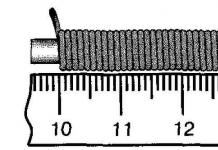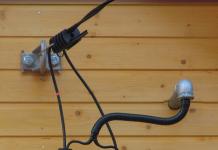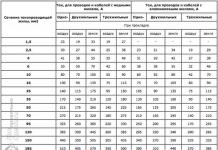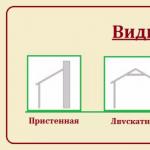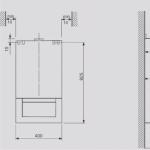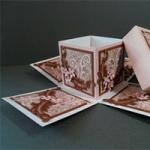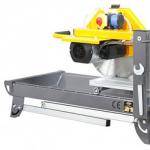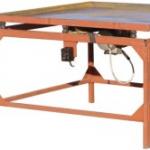One of the important and basic parts of electrical wiring is the cables that conduct current. In order for everything to work as it should, without short circuits and melted wires, it is important to select the wiring so that it can withstand the voltage. You can make sure that the wire is reliable, safe and meets operating requirements by calculating the wire cross-section. If the wire is of insufficient cross-section, it can lead to a short circuit and fire in the house. Let's figure out how to determine the wire cross-section to avoid such consequences.
Serious question
If you plan to replace electrical wiring, then first of all you need to decide what cross-section of wire is needed. When you calculate the planned current load on the wire, it will immediately become clear what cross-section is needed for normal operation. For this purpose, use the table below.

Let's say, having calculated everything, you have determined the current strength to be 27 A. It turns out that you need a two-core wire with a cross-section of 2.5 mm 2. You went to the store, bought a good wire, with a cross-section of 2.5 mm2 declared by the manufacturer, and installed the electrical wires. After the time has passed when the system was up and running, the machine on your dashboard turns off. This may indicate a damaged line.
After you inspect the wiring, you may find that there was a short circuit. The reason is simple - the insulation on the wire melted due to strong heating. But how can this be? You did everything right, calculated it, purchased the necessary wire. And the whole point is not in the calculations and your error with the connection. The whole reason lies in deception. Yes, precisely in deception, since very often manufacturers producing wires supply goods that do not correspond to the declared cross-section. For example, you bought a cable with a wire area of 2.5 mm 2, but when you checked it yourself, it turned out that the cable cross-section is only 2.1 mm 2, which is less than what you need in terms of power. So it turns out that the wire heats up, and the risk of a short circuit increases.

But why would cable companies do this? It's all about greed, since by lowering the cross-section of the wire, the manufacturing company saves quite a significant amount of money. Judge for yourself: to make 1000 m of wires with a cross-section of 2.5 mm 2, you will need approximately 22.3 kg of copper. But if you make them with a smaller cross-section, 2.1 mm 2, then their production will require 18.8 kg. It turns out that the savings in favor of the manufacturer are 3.5 kg of copper. And when large volumes of products are produced, this figure increases significantly.
So it turns out that determining the wire cross-section is an important and serious step that must be performed when installing wiring. This way you can avoid insulation melting, short circuits and, as a result, fire.
How can you determine the cable cross-section
So, you bought a wire, let's find out how you can measure its cross-section. For this purpose you will need:
- calipers;
- calculator;
- the cable itself;
- utility knife or stripper for removing insulation.

The cross section is determined by the diameter of the wire. Let's look at how to do this step by step.
- Take the wire and remove the insulation from it using a stripper or a utility knife.
- Using a caliper, measure the diameter of the wire.
- Now, you will have to remember your geometry lessons at school. In order to determine the area of a circle, there is a certain formula:
S cr = π r 2,
where the number π = 3.14, and r is the radius of the wire.
But here we have a problem: using a caliper it is impossible to measure the radius - only the diameter. Therefore, the formula needs to be slightly modified to suit the diameter. As we know, the radius is half the diameter. In order for our data to fit, the formula needs to be redone like this:
S cr = (π d 2)/4,
where d is the core diameter.
In this case, the formula can be shortened by dividing the number π by four. As a result, we arrive at the standard formula for calculating the cross-section of the core by diameter:
All that remains is to substitute the numbers into the formula and get the area of the circle, which will be its cross section. For example, the diameter of your copper wire is 1.68 mm. This number squared is 2.8224. Multiply 2.8224 by 0.785. If we round, then in the end the desired cross-section is 2.2 mm 2.
That's all, as you can see, this procedure will not take much time and effort, but it is a very important part of the electrical installation work. After all, even a deviation of a few tenths of a millimeter can play a cruel joke. But what if you are not an electrician and you don’t have a caliper at hand? Don’t rush to run to the store; there is a simple method for calculating the diameter using available tools.
A simple method for determining diameter

Everyone has everything they need at their fingertips. For this method you only need a pencil or pen and a ruler.
- First of all, take the wire whose cross-section you need to find out and remove 300–400 mm of insulation along its length.
- Take a pencil, pen, felt-tip pen, or whatever you have on hand, and wrap a wire around it. In order to achieve the most accurate result, the turns must be fitted closely one to one.
The more turns you make, the more accurate the result will be. The recommended quantity is 10 or more turns. - Then count the number of turns you wound around the pencil and write that number down or remember it.
- Using a ruler, measure the total length of the counted turns. For example, you got 19 turns that are 32 mm long.
- To determine the diameter of the wire, all that remains is to divide the length by the number of turns. It turns out like this: 32/19 = 1.68 mm.
That's all, now all that remains is to substitute the diameter of the wire into the formula and you will get a wire cross-section of 2.2 mm 2. This result can be considered accurate under two conditions: the turns were wound closely, and their number exceeds 10 pieces - the more, the better. As a result, you won't have to spend extra money.
The only disadvantage of this method: if the core has a large cross-section, you won’t be able to wrap it around a pencil.
How to measure the cross-section if the wire is stranded

Well, you say, if there is only one wire, it’s easy to calculate the cross-section. But what if it is multi-core? There are a lot of such individual wires, how can you recognize it in this case? Determining the cross-section of a stranded wire is not as difficult as it seems. All you need to do is determine the cross-section of one of the cores.
- First, take the wire and strip the insulation from it.
- Now all the wiring needs to be disconnected and their number recalculated.
- Take one of the wires and measure its diameter.
- Using the formula presented above, determine the area of one core.
- Having the cross-section of one core, you can find out the total cross-section. To do this, multiply the area of one wire by their total number. For example, you have a wire consisting of 15 cores. You learned that the cross-section of one wire is 0.2 mm 2. In order to find out their total cross-section, 0.2 must be multiplied by 15. We get: 0.2 × 15 = 3 mm 2.

But it should be taken into account that all the wires in the wire cannot be connected closely. Because they are round, there is an air gap between them. It needs to be taken into account. To do this, multiply the resulting result by 0.91. Let’s say if the wire cross-section is 3 mm 2, then multiplying it by a factor of 0.91, we get a cross-section of 2.7 mm 2. That's all. There is nothing complicated, you just need to follow the instructions.
As you can see, anyone who knows how to use formulas can determine the wire cross-section. But, despite the simplicity of this work, it is one of the most important steps that must be done before wiring throughout the house.
Standard apartment wiring is calculated for a maximum current consumption at a continuous load of 25 amperes (the circuit breaker that is installed at the entrance of wires into the apartment is also selected for this current strength) and is carried out with copper wire with a cross-section of 4.0 mm 2, which corresponds to a wire diameter of 2.26 mm and load power up to 6 kW.
According to the requirements of clause 7.1.35 of the PUE the cross-section of the copper core for residential electrical wiring must be at least 2.5 mm 2, which corresponds to a conductor diameter of 1.8 mm and a load current of 16 A. Electrical appliances with a total power of up to 3.5 kW can be connected to such electrical wiring.
What is wire cross-section and how to determine it
To see the cross-section of the wire, just cut it across and look at the cut from the end. The cut area is the cross-section of the wire. The larger it is, the more current the wire can transmit.

As can be seen from the formula, the cross-section of the wire is light according to its diameter. It is enough to multiply the diameter of the wire core by itself and by 0.785. For the cross-section of a stranded wire, you need to calculate the cross-section of one core and multiply by their number.
The diameter of the conductor can be determined using a caliper with an accuracy of 0.1 mm or a micrometer with an accuracy of 0.01 mm. If there are no instruments at hand, then an ordinary ruler will help out.
Section selection
copper wire electrical wiring by current strength
The magnitude of the electric current is indicated by the letter “ A" and is measured in Amperes. When choosing, a simple rule applies: The larger the cross-section of the wire, the better, so the result is rounded up.
| Table for selecting the cross-section and diameter of copper wire depending on the current strength | ||||||||||||||
|---|---|---|---|---|---|---|---|---|---|---|---|---|---|---|
| Maximum current, A | 1,0 | 2,0 | 3,0 | 4,0 | 5,0 | 6,0 | 10,0 | 16,0 | 20,0 | 25,0 | 32,0 | 40,0 | 50,0 | 63,0 |
| Standard section, mm 2 | 0,35 | 0,35 | 0,50 | 0,75 | 1,0 | 1,2 | 2,0 | 2,5 | 3,0 | 4,0 | 5,0 | 6,0 | 8,0 | 10,0 |
| Diameter, mm | 0,67 | 0,67 | 0,80 | 0,98 | 1,1 | 1,2 | 1,6 | 1,8 | 2,0 | 2,3 | 2,5 | 2,7 | 3,2 | 3,6 |
The data I have provided in the table is based on personal experience and guarantees reliable operation of electrical wiring under the most unfavorable conditions of its installation and operation. When choosing a wire cross-section based on the current value, it does not matter whether it is alternating current or direct current. The magnitude and frequency of the voltage in the electrical wiring also does not matter; it can be the on-board network of a DC car at 12 V or 24 V, an aircraft at 115 V with a frequency of 400 Hz, electrical wiring 220 V or 380 V with a frequency of 50 Hz, a high-voltage power line at 10,000 IN.
If the current consumption of an electrical appliance is not known, but the supply voltage and power are known, then the current can be calculated using the online calculator below.
It should be noted that at frequencies above 100 Hz, a skin effect begins to appear in wires when electric current flows, which means that with increasing frequency, the current begins to “press” against the outer surface of the wire and the actual cross-section of the wire decreases. Therefore, the choice of wire cross-section for high-frequency circuits is carried out according to different laws.
Determining the load capacity of 220 V electrical wiring
made of aluminum wire
In houses built a long time ago, electrical wiring is usually made of aluminum wires. If connections in junction boxes are made correctly, the service life of aluminum wiring can be one hundred years. After all, aluminum practically does not oxidize, and the service life of electrical wiring will be determined only by the service life of the plastic insulation and the reliability of the contacts at the connection points.
In the case of connecting additional energy-intensive electrical appliances in an apartment with aluminum wiring, it is necessary to determine by the cross-section or diameter of the wire cores its ability to withstand additional power. Using the table below, this is easy to do.
If your apartment wiring is made of aluminum wires and there is a need to connect a newly installed socket in a junction box with copper wires, then such a connection is made in accordance with the recommendations of the article Connecting aluminum wires.
Calculation of electrical wire cross-section
according to the power of connected electrical appliances
To select the cross-section of cable wire cores when laying electrical wiring in an apartment or house, you need to analyze the fleet of existing electrical household appliances from the point of view of their simultaneous use. The table provides a list of popular household electrical appliances indicating the current consumption depending on the power. You can find out the power consumption of your models yourself from the labels on the products themselves or data sheets; often the parameters are indicated on the packaging.
If the current consumed by an electrical appliance is not known, it can be measured using an ammeter.
Table of power consumption and current for household electrical appliances
at supply voltage 220 V
Typically, the power consumption of electrical appliances is indicated on the housing in watts (W or VA) or kilowatts (kW or kVA). 1 kW=1000 W.
| Table of power consumption and current for household electrical appliances | |||
|---|---|---|---|
| Household electrical appliance | Power consumption, kW (kVA) | Current consumption, A | Current consumption mode |
| Incandescent light bulb | 0,06 – 0,25 | 0,3 – 1,2 | Constantly |
| Electric kettle | 1,0 – 2,0 | 5 – 9 | Up to 5 minutes |
| Electric stove | 1,0 – 6,0 | 5 – 60 | Depends on operating mode |
| Microwave | 1,5 – 2,2 | 7 – 10 | Periodically |
| Electric meat grinder | 1,5 – 2,2 | 7 – 10 | Depends on operating mode |
| Toaster | 0,5 – 1,5 | 2 – 7 | Constantly |
| Grill | 1,2 – 2,0 | 7 – 9 | Constantly |
| Coffee grinder | 0,5 – 1,5 | 2 – 8 | Depends on operating mode |
| Coffee maker | 0,5 – 1,5 | 2 – 8 | Constantly |
| Electric oven | 1,0 – 2,0 | 5 – 9 | Depends on operating mode |
| Dishwasher | 1,0 – 2,0 | 5 – 9 | |
| Washing machine | 1,2 – 2,0 | 6 – 9 | Maximum from the moment of switching on until the water is heated |
| Dryer | 2,0 – 3,0 | 9 – 13 | Constantly |
| Iron | 1,2 – 2,0 | 6 – 9 | Periodically |
| Vacuum cleaner | 0,8 – 2,0 | 4 – 9 | Depends on operating mode |
| Heater | 0,5 – 3,0 | 2 – 13 | Depends on operating mode |
| Hair dryer | 0,5 – 1,5 | 2 – 8 | Depends on operating mode |
| Air conditioner | 1,0 – 3,0 | 5 – 13 | Depends on operating mode |
| Desktop computer | 0,3 – 0,8 | 1 – 3 | Depends on operating mode |
| Power tools (drill, jigsaw, etc.) | 0,5 – 2,5 | 2 – 13 | Depends on operating mode |
Current is also consumed by the refrigerator, lighting fixtures, radiotelephone, chargers, and TV in standby mode. But in total this power is no more than 100 W and can be ignored in calculations.
If you turn on all the electrical appliances in the house at the same time, you will need to select a wire cross-section capable of passing a current of 160 A. You will need a finger-thick wire! But such a case is unlikely. It’s hard to imagine that someone is capable of grinding meat, ironing, vacuuming and drying hair at the same time.
Calculation example. You got up in the morning, turned on the electric kettle, microwave, toaster and coffee maker. The current consumption will accordingly be 7 A + 8 A + 3 A + 4 A = 22 A. Taking into account the switched on lighting, refrigerator and, in addition, for example, a TV, the current consumption can reach 25 A.
for 220 V network
You can select the wire cross-section not only by the current strength, but also by the amount of power consumed. To do this, you need to make a list of all electrical appliances planned to be connected to a given section of electrical wiring, and determine how much power each of them consumes separately. Next, add up the data obtained and use the table below.
for 220 V network |
|||||||||||||||||
|---|---|---|---|---|---|---|---|---|---|---|---|---|---|---|---|---|---|
| Electrical appliance power, kW (kVA) | 0,1 | 0,3 | 0,5 | 0,7 | 0,9 | 1,0 | 1,2 | 1,5 | 1,8 | 2,0 | 2,5 | 3,0 | 3,5 | 4,0 | 4,5 | 5,0 | 6,0 |
| Standard section, mm 2 | 0,35 | 0,35 | 0,35 | 0,5 | 0,75 | 0,75 | 1,0 | 1,2 | 1,5 | 1,5 | 2,0 | 2,5 | 2,5 | 3,0 | 4,0 | 4,0 | 5,0 |
| Diameter, mm | 0,67 | 0,67 | 0,67 | 0,5 | 0,98 | 0,98 | 1,13 | 1,24 | 1,38 | 1,38 | 1,6 | 1,78 | 1,78 | 1,95 | 2,26 | 2,26 | 2,52 |
If there are several electrical appliances and for some the current consumption is known, and for others the power, then you need to determine the wire cross-section for each of them from the tables, and then add up the results.
Selecting the cross-section of copper wire according to power
for the car's on-board network 12 V
If, when connecting additional equipment to the vehicle’s on-board network, only its power consumption is known, then the cross-section of the additional electrical wiring can be determined using the table below.
| Table for choosing the cross-section and diameter of copper wire according to power for vehicle on-board network 12 V |
||||||||||||||||
|---|---|---|---|---|---|---|---|---|---|---|---|---|---|---|---|---|
| Electrical appliance power, watt (BA) | 10 | 30 | 50 | 80 | 100 | 200 | 300 | 400 | 500 | 600 | 700 | 800 | 900 | 1000 | 1100 | 1200 |
| Standard section, mm 2 | 0,35 | 0,5 | 0,75 | 1,2 | 1,5 | 3,0 | 4,0 | 6,0 | 8,0 | 8,0 | 10 | 10 | 10 | 16 | 16 | 16 |
| Diameter, mm | 0,67 | 0,5 | 0,8 | 1,24 | 1,38 | 1,95 | 2,26 | 2,76 | 3,19 | 3,19 | 3,57 | 3,57 | 3,57 | 4,51 | 4,51 | 4,51 |
Selecting the wire cross-section for connecting electrical appliances
to a three-phase network 380 V
When operating electrical appliances, for example, an electric motor, connected to a three-phase network, the consumed current no longer flows through two wires, but through three and, therefore, the amount of current flowing in each individual wire is somewhat less. This allows you to use a smaller cross-section wire to connect electrical appliances to a three-phase network.
To connect electrical appliances to a three-phase network with a voltage of 380 V, for example an electric motor, the wire cross-section for each phase is taken 1.75 times smaller than for connecting to a single-phase 220 V network.
Attention, when choosing a wire cross-section for connecting an electric motor based on power, it should be taken into account that the nameplate of the electric motor indicates the maximum mechanical power that the motor can create on the shaft, and not the electrical power consumed. The electrical power consumed by the electric motor, taking into account efficiency and cos φ, is approximately two times greater than that created on the shaft, which must be taken into account when choosing the wire cross-section based on the motor power indicated in the plate.
For example, you need to connect an electric motor that consumes power from a 2.0 kW network. The total current consumption of an electric motor of such power in three phases is 5.2 A. According to the table, it turns out that a wire with a cross-section of 1.0 mm 2 is needed, taking into account the above 1.0 / 1.75 = 0.5 mm 2. Therefore, to connect a 2.0 kW electric motor to a three-phase 380 V network, you will need a three-core copper cable with a cross-section of each core of 0.5 mm 2.

It is much easier to choose the wire cross-section for connecting a three-phase motor based on the current consumption, which is always indicated on the nameplate. For example, in the nameplate shown in the photograph, the current consumption of a motor with a power of 0.25 kW for each phase at a supply voltage of 220 V (motor windings are connected in a delta pattern) is 1.2 A, and at a voltage of 380 V (motor windings are connected in a delta pattern) "star" circuit) is only 0.7 A. Taking the current indicated on the nameplate, according to the table for selecting the wire cross-section for apartment wiring, select a wire with a cross-section of 0.35 mm 2 when connecting the electric motor windings according to the "triangle" or 0.15 mm pattern 2 when connected in a star configuration.
About choosing a cable brand for home wiring
Making apartment electrical wiring from aluminum wires at first glance seems cheaper, but operating costs due to low reliability of contacts over time will be many times higher than the costs of electrical wiring made from copper. I recommend making the wiring exclusively from copper wires! Aluminum wires are indispensable when laying overhead electrical wiring, as they are light and cheap and, when properly connected, serve reliably for a long time.
Which wire is better to use when installing electrical wiring, single-core or stranded? From the point of view of the ability to conduct current per unit of cross-section and installation, single-core is better. So for home wiring you only need to use solid wire. Stranded allows multiple bends, and the thinner the conductors in it, the more flexible and durable it is. Therefore, stranded wire is used to connect non-stationary electrical appliances to the electrical network, such as an electric hair dryer, an electric razor, an electric iron and all the others.
After deciding on the cross-section of the wire, the question arises about the brand of cable for electrical wiring. The choice here is not great and is represented by only a few brands of cables: PUNP, VVGng and NYM.
PUNP cable since 1990, in accordance with the decision of Glavgosenergonadzor “On the ban on the use of wires such as APVN, PPBN, PEN, PUNP, etc., produced according to TU 16-505. 610-74 instead of APV, APPV, PV and PPV wires according to GOST 6323-79*" is prohibited for use.
Cable VVG and VVGng - copper wires in double polyvinyl chloride insulation, flat shape. Designed for operation at ambient temperatures from −50°С to +50°С, for wiring inside buildings, outdoors, in the ground when laid in tubes. Service life up to 30 years. The letters “ng” in the brand designation indicate the non-flammability of the wire insulation. Two-, three- and four-core wires are available with core cross-sections from 1.5 to 35.0 mm 2 . If in the cable designation there is a letter A (AVVG) before VVG, then the conductors in the wire are aluminum.

The NYM cable (its Russian analogue is the VVG cable), with copper cores, round in shape, with non-flammable insulation, complies with the German standard VDE 0250. Technical characteristics and scope of application are almost the same as the VVG cable. Two-, three- and four-core wires are available with core cross-sections from 1.5 to 4.0 mm 2 .

As you can see, the choice for laying electrical wiring is not large and is determined depending on what shape the cable is more suitable for installation, round or flat. A round-shaped cable is more convenient to lay through walls, especially if the connection is made from the street into the room. You will need to drill a hole slightly larger than the diameter of the cable, and with a larger wall thickness this becomes relevant. For internal wiring, it is more convenient to use a VVG flat cable.
Parallel connection of electrical wiring wires
There are hopeless situations when you urgently need to lay wiring, but there is no wire of the required cross-section available. In this case, if there is a wire with a smaller cross-section than necessary, then the wiring can be made from two or more wires, connecting them in parallel. The main thing is that the sum of the sections of each of them is not less than the calculated one.
For example, there are three wires with a cross section of 2, 3 and 5 mm 2, but according to calculations, 10 mm 2 is needed. Connect them all in parallel and the wiring will handle up to 50 amps. Yes, you yourself have repeatedly seen the parallel connection of a large number of thin conductors to transmit large currents. For example, welding uses a current of up to 150 A and in order for the welder to control the electrode, a flexible wire is needed. It is made from hundreds of thin copper wires connected in parallel. In a car, the battery is also connected to the on-board network using the same flexible stranded wire, since when starting the engine, the starter consumes current from the battery up to 100 A. And when installing and removing the battery, the wires must be taken to the side, that is, the wire must be flexible enough .
The method of increasing the cross-section of an electrical wire by connecting several wires of different diameters in parallel can be used only as a last resort. When laying home electrical wiring, it is permissible to connect in parallel only wires of the same cross-section taken from the same reel.
Online calculators for calculating the cross-section and diameter of a wire
Using the online calculator presented below, you can solve the inverse problem - determine the diameter of the conductor by cross-section.
How to calculate the cross-section of a stranded wire
Stranded wire, or as it is also called stranded or flexible, is a single-core wire twisted together. To calculate the cross-section of a stranded wire, you must first calculate the cross-section of one wire, and then multiply the resulting result by their number.

Let's look at an example. There is a multi-core flexible wire, in which there are 15 cores with a diameter of 0.5 mm. The cross-section of one core is 0.5 mm × 0.5 mm × 0.785 = 0.19625 mm 2, after rounding we get 0.2 mm 2. Since we have 15 wires in the wire, to determine the cable cross-section we need to multiply these numbers. 0.2 mm 2 ×15=3 mm 2. It remains to determine from the table that such a stranded wire will withstand a current of 20 A.
You can estimate the load capacity of a stranded wire without measuring the diameter of an individual conductor by measuring the total diameter of all twisted wires. But since the wires are round, there are air gaps between them. To eliminate the gap area, you need to multiply the result of the wire cross-section obtained from the formula by a factor of 0.91. When measuring the diameter, you need to make sure that the stranded wire does not flatten.
Let's look at an example. As a result of measurements, the stranded wire has a diameter of 2.0 mm. Let's calculate its cross-section: 2.0 mm × 2.0 mm × 0.785 × 0.91 = 2.9 mm 2. Using the table (see below), we determine that this stranded wire will withstand a current of up to 20 A.
The table shows power, current and cross sections of cables and wires, For calculations and selection of cables and wires, cable materials and electrical equipment.
The calculation used data from the PUE tables and active power formulas for single-phase and three-phase symmetrical loads.
Below are tables for cables and wires with copper and aluminum wire cores.
| Copper conductors of wires and cables | ||||
| Voltage, 220 V | Voltage, 380 V | current, A | power, kWt | current, A | power, kWt |
| 1,5 | 19 | 4,1 | 16 | 10,5 |
| 2,5 | 27 | 5,9 | 25 | 16,5 |
| 4 | 38 | 8,3 | 30 | 19,8 |
| 6 | 46 | 10,1 | 40 | 26,4 |
| 10 | 70 | 15,4 | 50 | 33,0 |
| 16 | 85 | 18,7 | 75 | 49,5 |
| 25 | 115 | 25,3 | 90 | 59,4 |
| 35 | 135 | 29,7 | 115 | 75,9 |
| 50 | 175 | 38,5 | 145 | 95,7 |
| 70 | 215 | 47,3 | 180 | 118,8 |
| 95 | 260 | 57,2 | 220 | 145,2 |
| 120 | 300 | 66,0 | 260 | 171,6 |
| Cross-section of current-carrying conductor, mm 2 | Aluminum conductors of wires and cables | |||
| Voltage, 220 V | Voltage, 380 V | current, A | power, kWt | current, A | power, kWt |
| 2,5 | 20 | 4,4 | 19 | 12,5 |
| 4 | 28 | 6,1 | 23 | 15,1 |
| 6 | 36 | 7,9 | 30 | 19,8 |
| 10 | 50 | 11,0 | 39 | 25,7 |
| 16 | 60 | 13,2 | 55 | 36,3 |
| 25 | 85 | 18,7 | 70 | 46,2 |
| 35 | 100 | 22,0 | 85 | 56,1 |
| 50 | 135 | 29,7 | 110 | 72,6 |
| 70 | 165 | 36,3 | 140 | 92,4 |
| 95 | 200 | 44,0 | 170 | 112,2 |
| 120 | 230 | 50,6 | 200 | 132,0 |
Example of cable cross-section calculation
Task: to power the heating element with a power of W=4.75 kW with copper wire in the cable channel.
Current calculation: I = W/U. We know the voltage: 220 volts. According to the formula, the flowing current I = 4750/220 = 21.6 amperes.
We focus on copper wire, so we take the value of the diameter of the copper core from the table. In the 220V - copper conductors column we find a current value exceeding 21.6 amperes, this is a line with a value of 27 amperes. From the same line we take the cross-section of the conductive core equal to 2.5 squares.
Calculation of the required cable cross-section based on the type of cable or wire
| № | Number of veins section mm. Cables (wires) | Outer diameter mm. | Pipe diameter mm. | Acceptable long current (A) for wires and cables when laying: | Permissible continuous current for rectangular copper bars sections (A) PUE |
|||||||||||
| VVG | VVGng | KVVG | KVVGE | NYM | PV1 | PV3 | PVC (HDPE) | Met.tr. Du | in the air | in the ground | Section, tires mm | Number of buses per phase | ||||
| 1 | 1x0.75 | 2,7 | 16 | 20 | 15 | 15 | 1 | 2 | 3 | |||||||
| 2 | 1x1 | 2,8 | 16 | 20 | 17 | 17 | 15x3 | 210 | ||||||||
| 3 | 1x1.5 | 5,4 | 5,4 | 3 | 3,2 | 16 | 20 | 23 | 33 | 20x3 | 275 | |||||
| 4 | 1x2.5 | 5,4 | 5,7 | 3,5 | 3,6 | 16 | 20 | 30 | 44 | 25x3 | 340 | |||||
| 5 | 1x4 | 6 | 6 | 4 | 4 | 16 | 20 | 41 | 55 | 30x4 | 475 | |||||
| 6 | 1x6 | 6,5 | 6,5 | 5 | 5,5 | 16 | 20 | 50 | 70 | 40x4 | 625 | |||||
| 7 | 1x10 | 7,8 | 7,8 | 5,5 | 6,2 | 20 | 20 | 80 | 105 | 40x5 | 700 | |||||
| 8 | 1x16 | 9,9 | 9,9 | 7 | 8,2 | 20 | 20 | 100 | 135 | 50x5 | 860 | |||||
| 9 | 1x25 | 11,5 | 11,5 | 9 | 10,5 | 32 | 32 | 140 | 175 | 50x6 | 955 | |||||
| 10 | 1x35 | 12,6 | 12,6 | 10 | 11 | 32 | 32 | 170 | 210 | 60x6 | 1125 | 1740 | 2240 | |||
| 11 | 1x50 | 14,4 | 14,4 | 12,5 | 13,2 | 32 | 32 | 215 | 265 | 80x6 | 1480 | 2110 | 2720 | |||
| 12 | 1x70 | 16,4 | 16,4 | 14 | 14,8 | 40 | 40 | 270 | 320 | 100x6 | 1810 | 2470 | 3170 | |||
| 13 | 1x95 | 18,8 | 18,7 | 16 | 17 | 40 | 40 | 325 | 385 | 60x8 | 1320 | 2160 | 2790 | |||
| 14 | 1x120 | 20,4 | 20,4 | 50 | 50 | 385 | 445 | 80x8 | 1690 | 2620 | 3370 | |||||
| 15 | 1x150 | 21,1 | 21,1 | 50 | 50 | 440 | 505 | 100x8 | 2080 | 3060 | 3930 | |||||
| 16 | 1x185 | 24,7 | 24,7 | 50 | 50 | 510 | 570 | 120x8 | 2400 | 3400 | 4340 | |||||
| 17 | 1x240 | 27,4 | 27,4 | 63 | 65 | 605 | 60x10 | 1475 | 2560 | 3300 | ||||||
| 18 | 3x1.5 | 9,6 | 9,2 | 9 | 20 | 20 | 19 | 27 | 80x10 | 1900 | 3100 | 3990 | ||||
| 19 | 3x2.5 | 10,5 | 10,2 | 10,2 | 20 | 20 | 25 | 38 | 100x10 | 2310 | 3610 | 4650 | ||||
| 20 | 3x4 | 11,2 | 11,2 | 11,9 | 25 | 25 | 35 | 49 | 120x10 | 2650 | 4100 | 5200 | ||||
| 21 | 3x6 | 11,8 | 11,8 | 13 | 25 | 25 | 42 | 60 | rectangular copper bars (A) Schneider Electric IP30 |
|||||||
| 22 | 3x10 | 14,6 | 14,6 | 25 | 25 | 55 | 90 | |||||||||
| 23 | 3x16 | 16,5 | 16,5 | 32 | 32 | 75 | 115 | |||||||||
| 24 | 3x25 | 20,5 | 20,5 | 32 | 32 | 95 | 150 | |||||||||
| 25 | 3x35 | 22,4 | 22,4 | 40 | 40 | 120 | 180 | Section, tires mm | Number of buses per phase | |||||||
| 26 | 4x1 | 8 | 9,5 | 16 | 20 | 14 | 14 | 1 | 2 | 3 | ||||||
| 27 | 4x1.5 | 9,8 | 9,8 | 9,2 | 10,1 | 20 | 20 | 19 | 27 | 50x5 | 650 | 1150 | ||||
| 28 | 4x2.5 | 11,5 | 11,5 | 11,1 | 11,1 | 20 | 20 | 25 | 38 | 63x5 | 750 | 1350 | 1750 | |||
| 29 | 4x50 | 30 | 31,3 | 63 | 65 | 145 | 225 | 80x5 | 1000 | 1650 | 2150 | |||||
| 30 | 4x70 | 31,6 | 36,4 | 80 | 80 | 180 | 275 | 100x5 | 1200 | 1900 | 2550 | |||||
| 31 | 4x95 | 35,2 | 41,5 | 80 | 80 | 220 | 330 | 125x5 | 1350 | 2150 | 3200 | |||||
| 32 | 4x120 | 38,8 | 45,6 | 100 | 100 | 260 | 385 | Permissible continuous current for rectangular copper bars (A) Schneider Electric IP31 |
||||||||
| 33 | 4x150 | 42,2 | 51,1 | 100 | 100 | 305 | 435 | |||||||||
| 34 | 4x185 | 46,4 | 54,7 | 100 | 100 | 350 | 500 | |||||||||
| 35 | 5x1 | 9,5 | 10,3 | 16 | 20 | 14 | 14 | |||||||||
| 36 | 5x1.5 | 10 | 10 | 10 | 10,9 | 10,3 | 20 | 20 | 19 | 27 | Section, tires mm | Number of buses per phase | ||||
| 37 | 5x2.5 | 11 | 11 | 11,1 | 11,5 | 12 | 20 | 20 | 25 | 38 | 1 | 2 | 3 | |||
| 38 | 5x4 | 12,8 | 12,8 | 14,9 | 25 | 25 | 35 | 49 | 50x5 | 600 | 1000 | |||||
| 39 | 5x6 | 14,2 | 14,2 | 16,3 | 32 | 32 | 42 | 60 | 63x5 | 700 | 1150 | 1600 | ||||
| 40 | 5x10 | 17,5 | 17,5 | 19,6 | 40 | 40 | 55 | 90 | 80x5 | 900 | 1450 | 1900 | ||||
| 41 | 5x16 | 22 | 22 | 24,4 | 50 | 50 | 75 | 115 | 100x5 | 1050 | 1600 | 2200 | ||||
| 42 | 5x25 | 26,8 | 26,8 | 29,4 | 63 | 65 | 95 | 150 | 125x5 | 1200 | 1950 | 2800 | ||||
| 43 | 5x35 | 28,5 | 29,8 | 63 | 65 | 120 | 180 | |||||||||
| 44 | 5x50 | 32,6 | 35 | 80 | 80 | 145 | 225 | |||||||||
| 45 | 5x95 | 42,8 | 100 | 100 | 220 | 330 | ||||||||||
| 46 | 5x120 | 47,7 | 100 | 100 | 260 | 385 | ||||||||||
| 47 | 5x150 | 55,8 | 100 | 100 | 305 | 435 | ||||||||||
| 48 | 5x185 | 61,9 | 100 | 100 | 350 | 500 | ||||||||||
| 49 | 7x1 | 10 | 11 | 16 | 20 | 14 | 14 | |||||||||
| 50 | 7x1.5 | 11,3 | 11,8 | 20 | 20 | 19 | 27 | |||||||||
| 51 | 7x2.5 | 11,9 | 12,4 | 20 | 20 | 25 | 38 | |||||||||
| 52 | 10x1 | 12,9 | 13,6 | 25 | 25 | 14 | 14 | |||||||||
| 53 | 10x1.5 | 14,1 | 14,5 | 32 | 32 | 19 | 27 | |||||||||
| 54 | 10x2.5 | 15,6 | 17,1 | 32 | 32 | 25 | 38 | |||||||||
| 55 | 14x1 | 14,1 | 14,6 | 32 | 32 | 14 | 14 | |||||||||
| 56 | 14x1.5 | 15,2 | 15,7 | 32 | 32 | 19 | 27 | |||||||||
| 57 | 14x2.5 | 16,9 | 18,7 | 40 | 40 | 25 | 38 | |||||||||
| 58 | 19x1 | 15,2 | 16,9 | 40 | 40 | 14 | 14 | |||||||||
| 59 | 19x1.5 | 16,9 | 18,5 | 40 | 40 | 19 | 27 | |||||||||
| 60 | 19x2.5 | 19,2 | 20,5 | 50 | 50 | 25 | 38 | |||||||||
| 61 | 27x1 | 18 | 19,9 | 50 | 50 | 14 | 14 | |||||||||
| 62 | 27x1.5 | 19,3 | 21,5 | 50 | 50 | 19 | 27 | |||||||||
| 63 | 27x2.5 | 21,7 | 24,3 | 50 | 50 | 25 | 38 | |||||||||
| 64 | 37x1 | 19,7 | 21,9 | 50 | 50 | 14 | 14 | |||||||||
| 65 | 37x1.5 | 21,5 | 24,1 | 50 | 50 | 19 | 27 | |||||||||
| 66 | 37x2.5 | 24,7 | 28,5 | 63 | 65 | 25 | 38 | |||||||||
Very often, before purchasing a wire, it becomes necessary to independently determine its cross-section, so as not to become a victim of deception. In addition, you have to measure the diameter of the cores when adding a new electrical point if there are no letter markings on the old wiring. Next, we will tell you how to take measurements correctly and what determination methods can be used for this.
The important point is that even if you correctly carry out all the calculations and select the appropriate product, such a nuisance as an accident may still occur. This is due to the fact that the cross-section of the cores indicated on does not always correspond to the actual values. This is only the fault of the manufacturer, because undoubtedly the characteristics do not match due to some economic “tricks” in the company. Sometimes there are no markings on the shelves at all, which also casts doubt on their quality.
You ask: “Why does a company need to spoil its reputation?”, to which you can immediately find several logical answers:
- The plant decided to save on the quality of the product. For example, if you make a 2.5 mm core thinner by 0.2 mm2, you can gain several kilograms of metal per 1 linear kilometer. With mass production, the savings are quite significant.
- In the struggle for a “place in the sun,” electrical wiring companies are trying to lure consumers to them by making the price lower than that of their competitors. Accordingly, the low price is set due to a slight reduction in diameter (not noticeable to the eye).
As you can see, both answers are quite reasonable, so it’s better to be careful and do a few simple calculations, which we’ll talk about next.
Determination methods
There are several ways to determine cable cross-section. They all boil down to first calculating the diameter of the core, and then using small calculations to find out the final value.
Method No. 1 – Devices to help!
Today, there are engineering instruments with which you can easily determine the diameter of a wire or cable core. Such instruments include a caliper and a micrometer (click on the photo to view all the tools).
This method of determination is the most accurate, but the “other side of the coin” is the cost of the caliper/micrometer itself. The price, of course, is not astronomical, but for one-time use there is no point in purchasing this tool.
Most often, this option is chosen by professional electricians whose lives are directly related to. Having a caliper, you can most accurately determine the cross-section of the wire on your own. The advantage of this technique is that you can measure the diameter of the cores even on a section of a working line (for example, in a socket).
After the measurement, you must use the following formula:

Don't forget that Pi is 3.14. To simplify the formula as much as possible, you can divide 3.14 by 4, after which the calculations will be reduced to multiplying 0.785 by the diameter squared!
Method number 2 - Using a ruler
If you do not want to spend money (and you are doing the right thing!), then we recommend using a simple “old-fashioned” method to determine the cross-section of the wire by its diameter. If you have a wire, a simple pencil and a ruler, you can find the answer in a matter of minutes. All you need is to strip the core of insulation, then tightly wind it onto a pencil (as shown in the picture) and use a ruler to measure the total length of the winding.

The essence of the method is that it is necessary to measure the total length of the wound conductor and divide it by the number of cores. The resulting value is the diameter that you need to determine.

Despite its simplicity, the calculations have their own peculiarity:
- the more cores are wound around the pencil, the more accurate the result will be, the minimum number of turns is 15;
- the turns must be pressed tightly against each other so that there is no free space, which will significantly increase the error;
- the determination must be carried out several times (changing the initial side of the measurement, turning the ruler over, etc.). Again, the more calculations, the smaller the error.
We draw your attention to the significant disadvantages of this method. Firstly, only thin conductors are suitable for measurement (due to the fact that a thick cable will be difficult to wind). Secondly, in the store before purchasing for this technique, you need to separately purchase a small piece of the product.
After all the measurements, you must use the same formula that we indicated above. The video shows an example of determining the cross-section of a conductor using a ruler:
Using rulers and formulas
Method #3 – Using tables
Instead of determining the cable cross-section using a formula, you can simply use ready-made tables that will reduce your time and make the result more accurate.
The table is quite simple: one column shows the diameters of the cores, the second shows their cross sections in squares.

We've provided existing methods, but that's not all.
- In addition to the cross-section of the product, pay attention to the metal of the core. The copper or aluminum core must have a characteristic rich color. If the color is questionable, then most likely it is an alloy of metals, which allows the manufacturer to save money. Such an alloy is extremely dangerous for... its current conductivity and rated loads are several times less than that of the original product.
- The cross-section needs to be determined only by the core. Even if the product appears to be of normal thickness, it is possible that the reduced dimensions of the core were compensated by an increased layer of insulation.
- If you are in doubt about the size of the conductor, purchase a larger gauge wire. The power reserve will definitely not damage your electrical wiring!
- If you are dealing with a cable, the calculation will be slightly different (due to the fact that the cable may consist of n number of wires). To correctly carry out the calculations, you must first determine the diameter of each individual wire, then sum up all the values and select products according to the final number.

When designing the circuit of any electrical installation and installation, choosing the cross-section of wires and cables is a mandatory step. In order to correctly select the power wire of the required cross-section, it is necessary to take into account the maximum consumption.
Wire cross-section is measured in square millimeters or "squares". Each “square” of aluminum wire is capable of passing through itself for a long time, heating up to permissible limits, a maximum of only 4 amperes, and copper wires 10 amperes of current. Accordingly, if some electrical consumer consumes power equal to 4 kilowatts (4000 watts), then at a voltage of 220 volts the current strength will be equal to 4000/220 = 18.18 amperes and to power it it is enough to supply electricity to it with a copper wire with a cross-section of 18.18/ 10=1.818 square. True, in this case the wire will work to the limit of its capabilities, so you should take a margin of at least 15% for the cross-section. We get 2.091 squares. And now we will select the nearest wire of standard cross-section. Those. We must conduct wiring to this consumer with a copper wire with a cross-section of 2 square millimeters, called the current load. Current values can be easily determined by knowing the rated power of consumers using the formula: I = P/220. The aluminum wire will be correspondingly 2.5 times thicker.
Based on the calculation of sufficient mechanical strength, open power wiring is usually carried out with a wire with a cross-section of at least 4 square meters. mm. If you need to know with greater accuracy the long-term permissible current load for copper wires and cables, you can use the tables.
|
Copper conductors of wires and cables |
||||
| Voltage, 220 V | Voltage, 380 V | |||
| current, A | power, kWt | current, A | power, kWt | |
| 1,5 | 19 | 4,1 | 16 | 10,5 |
| 2,5 | 27 | 5,9 | 25 | 16,5 |
| 4 | 38 | 8,3 | 30 | 19,8 |
| 6 | 46 | 10,1 | 40 | 26,4 |
| 10 | 70 | 15,4 | 50 | 33,0 |
| 16 | 85 | 18,7 | 75 | 49,5 |
| 25 | 115 | 25,3 | 90 | 59,4 |
| 35 | 135 | 29,7 | 115 | 75,9 |
| 50 | 175 | 38,5 | 145 | 95,7 |
| 70 | 215 | 47,3 | 180 | 118,8 |
| 95 | 260 | 57,2 | 220 | 145,2 |
| 120 | 300 | 66,0 | 260 | 171,6 |
|
Aluminum conductors of wires and cables |
||||
| Cross-section of current-carrying conductor, mm. | Voltage, 220 V | Voltage, 380 V | ||
| current, A | power, kWt | current, A | power, kWt | |
| 2,5 | 20 | 4,4 | 19 | 12,5 |
| 4 | 28 | 6,1 | 23 | 15,1 |
| 6 | 36 | 7,9 | 30 | 19,8 |
| 10 | 50 | 11,0 | 39 | 25,7 |
| 16 | 60 | 13,2 | 55 | 36,3 |
| 25 | 85 | 18,7 | 70 | 46,2 |
| 35 | 100 | 22,0 | 85 | 56,1 |
| 50 | 135 | 29,7 | 110 | 72,6 |
| 70 | 165 | 36,3 | 140 | 92,4 |
| 95 | 200 | 44,0 | 170 | 112,2 |
| 120 | 230 | 50,6 | 200 | 132,0 |
|
Permissible continuous current for wires and cords with rubber and polyvinyl chloride insulation with copper conductors, for example |
||||||
| Cross-section of current-carrying conductor, mm. | Open | |||||
| Two single-core | Three single-core | Four single-core | One two-wire | One three-wire | ||
| 0,5 | 11 | - | - | - | - | - |
| 0,75 | 15 | - | - | - | - | - |
| 1 | 17 | 16 | 15 | 14 | 15 | 14 |
| 1,2 | 20 | 18 | 16 | 15 | 16 | 14,5 |
| 1,5 | 23 | 19 | 17 | 16 | 18 | 15 |
| 2 | 26 | 24 | 22 | 20 | 23 | 19 |
| 2,5 | 30 | 27 | 25 | 25 | 25 | 21 |
| 3 | 34 | 32 | 28 | 26 | 28 | 24 |
| 4 | 41 | 38 | 35 | 30 | 32 | 27 |
| 5 | 46 | 42 | 39 | 34 | 37 | 31 |
| 6 | 50 | 46 | 42 | 40 | 40 | 34 |
| 8 | 62 | 54 | 51 | 46 | 48 | 43 |
| 10 | 80 | 70 | 60 | 50 | 55 | 50 |
| 16 | 100 | 85 | 80 | 75 | 80 | 70 |
| 25 | 140 | 115 | 100 | 90 | 100 | 85 |
| 35 | 170 | 135 | 125 | 115 | 125 | 100 |
| 50 | 215 | 185 | 170 | 150 | 160 | 135 |
| 70 | 270 | 225 | 210 | 185 | 195 | 175 |
| 95 | 330 | 275 | 255 | 225 | 245 | 215 |
| 120 | 385 | 315 | 290 | 260 | 295 | 250 |
| 150 | 440 | 360 | 330 | - | - | - |
| 185 | 510 | - | - | - | - | - |
| 240 | 605 | - | - | - | - | - |
| 300 | 695 | - | - | - | - | - |
| 400 | 830 | - | - | - | - | - |
|
Permissible continuous current for wires and cords with rubber and polyvinyl chloride insulation with aluminum conductors |
||||||
| Cross-section of current-carrying conductor, mm. | Open | Current, A, for wires laid in one pipe | ||||
| Two single-core | Three single-core | Four single-core | One two-wire | One three-wire | ||
| 2 | 21 | 19 | 18 | 15 | 17 | 14 |
| 2,5 | 24 | 20 | 19 | 19 | 19 | 16 |
| 3 | 27 | 24 | 22 | 21 | 22 | 18 |
| 4 | 32 | 28 | 28 | 23 | 25 | 21 |
| 5 | 36 | 32 | 30 | 27 | 28 | 24 |
| 6 | 39 | 36 | 32 | 30 | 31 | 26 |
| 8 | 46 | 43 | 40 | 37 | 38 | 32 |
| 10 | 60 | 50 | 47 | 39 | 42 | 38 |
| 16 | 75 | 60 | 60 | 55 | 60 | 55 |
| 25 | 105 | 85 | 80 | 70 | 75 | 65 |
| 35 | 130 | 100 | 95 | 85 | 95 | 75 |
| 50 | 165 | 140 | 130 | 120 | 125 | 105 |
| 70 | 210 | 175 | 165 | 140 | 150 | 135 |
| 95 | 255 | 215 | 200 | 175 | 190 | 165 |
| 120 | 295 | 245 | 220 | 200 | 230 | 190 |
| 150 | 340 | 275 | 255 | - | - | - |
| 185 | 390 | - | - | - | - | - |
| 240 | 465 | - | - | - | - | - |
| 300 | 535 | - | - | - | - | - |
| 400 | 645 | - | - | - | - | - |
|
Permissible continuous current for wires with copper conductors with rubber insulation in metal protective sheaths and cables with copper conductors with rubber insulation in lead, polyvinyl chloride, |
|||||||
| Cross-section of current-carrying conductor, mm. | Current*, A, for wires and cables | ||||||
| single-core | two-wire | three-wire | |||||
| when laying | |||||||
| in the air | in the air | in the ground | in the air | in the ground | |||
| 1,5 | 23 | 19 | 33 | 19 | 27 | ||
| 2,5 | 30 | 27 | 44 | 25 | 38 | ||
| 4 | 41 | 38 | 55 | 35 | 49 | ||
| 6 | 50 | 50 | 70 | 42 | 60 | ||
| 10 | 80 | 70 | 105 | 55 | 90 | ||
| 16 | 100 | 90 | 135 | 75 | 115 | ||
| 25 | 140 | 115 | 175 | 95 | 150 | ||
| 35 | 170 | 140 | 210 | 120 | 180 | ||
| 50 | 215 | 175 | 265 | 145 | 225 | ||
| 70 | 270 | 215 | 320 | 180 | 275 | ||
| 95 | 325 | 260 | 385 | 220 | 330 | ||
| 120 | 385 | 300 | 445 | 260 | 385 | ||
| 150 | 440 | 350 | 505 | 305 | 435 | ||
| 185 | 510 | 405 | 570 | 350 | 500 | ||
| 240 | 605 | - | - | - | - | ||
* Currents refer to cables and wires with and without a neutral core.
|
Permissible continuous current for cables with aluminum conductors with rubber or plastic insulation in lead, polyvinyl chloride and rubber sheaths, armored and unarmored |
|||||||
| Cross-section of current-carrying conductor, mm. | Current, A, for wires and cables | ||||||
| single-core | two-wire | three-wire | |||||
| when laying | |||||||
| in the air | in the air | in the ground | in the air | in the ground | |||
| 2,5 | 23 | 21 | 34 | 19 | 29 | ||
| 4 | 31 | 29 | 42 | 27 | 38 | ||
| 6 | 38 | 38 | 55 | 32 | 46 | ||
| 10 | 60 | 55 | 80 | 42 | 70 | ||
| 16 | 75 | 70 | 105 | 60 | 90 | ||
| 25 | 105 | 90 | 135 | 75 | 115 | ||
| 35 | 130 | 105 | 160 | 90 | 140 | ||
| 50 | 165 | 135 | 205 | 110 | 175 | ||
| 70 | 210 | 165 | 245 | 140 | 210 | ||
| 95 | 250 | 200 | 295 | 170 | 255 | ||
| 120 | 295 | 230 | 340 | 200 | 295 | ||
| 150 | 340 | 270 | 390 | 235 | 335 | ||
| 185 | 390 | 310 | 440 | 270 | 385 | ||
| 240 | 465 | - | - | - | - | ||
Permissible continuous currents for four-core cables with plastic insulation for voltages up to 1 kV can be selected according to this table as for three-core cables, but with a coefficient of 0.92.
| Summary table of wire cross-sections, current, power and load characteristics | |||||
| Cross-section of copper conductors of wires and cables, sq. mm | Permissible continuous load current for wires and cables, A | Rated current of the circuit breaker, A | Maximum current of the circuit breaker, A | Maximum single-phase load power at U=220 V | Characteristics of an approximate single-phase household load |
| 1,5 | 19 | 10 | 16 | 4,1 | lighting and alarm group |
| 2,5 | 27 | 16 | 20 | 5,9 | socket groups and electric floors |
| 4 | 38 | 25 | 32 | 8,3 | water heaters and air conditioners |
| 6 | 46 | 32 | 40 | 10,1 | electric stoves and ovens |
| 10 | 70 | 50 | 63 | 15,4 | input supply lines |
The table shows data based on the PUE for selecting cross-sections of cable and wire products, as well as rated and maximum possible currents of circuit breakers for single-phase household loads most often used in everyday life.
We hope this information was useful to you. We remind you that from us you can buy excellent quality at a low price.
